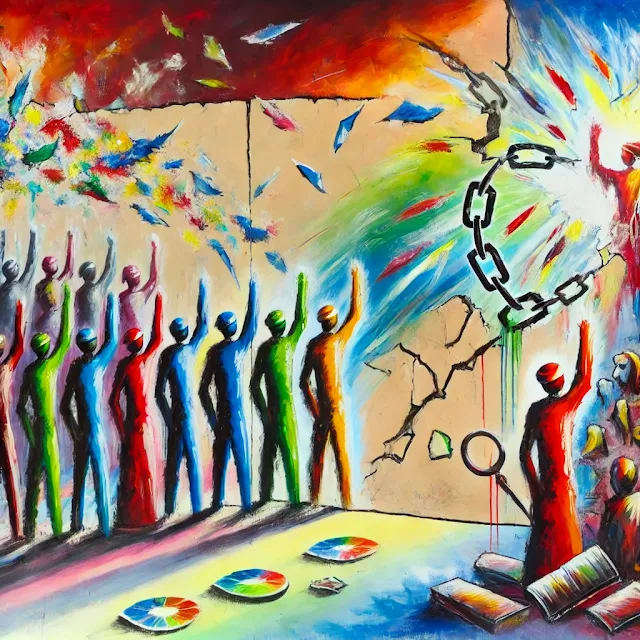How Contemporary Artists are Breaking Boundaries and Demanding a Seat at the Table
Contemporary art isn’t just a form of expression—it’s a battleground. In a world where identity politics ignite cultural firestorms, today's artists are armed with paintbrushes, cameras, and sculptures, confronting society's deepest taboos head-on. As our global village becomes ever more aware of the complexities of identity, the art world has become the ultimate stage for artists who refuse to be silent. Race, gender, sexuality, and cultural heritage are no longer just themes—they're weapons, disrupting the status quo and demanding an urgent reckoning.
Art That Dares to Defy: A Look at the Power of Identity
The exploration of identity in contemporary art isn’t for the faint-hearted. It’s raw, messy, and relentless, digging deep into the personal, social, and cultural fabric of existence. For some artists, this isn’t just self-expression—it’s survival. Their art tears apart stereotypes, exposes injustice, and flaunts diversity in the face of outdated norms. It’s a provocation to the world: Will you dare to look? Will you dare to see?
Meet the Artists Leading the Revolution
-
Kehinde Wiley: Forget the old European portraits of white royalty. Wiley turns the art world on its head by placing Black men and women—once erased from such grandeur—into those very spaces of power and prestige. His vibrant portraits don’t just hang in museums—they reclaim them.
-
Kara Walker: You want provocative? Walker delivers. Her disturbing silhouettes force us to relive America's darkest moments—violence, exploitation, slavery. Walker doesn't just tell history; she rubs our noses in it until we confront the ugly truths we've long tried to ignore.
-
Zanele Muholi: Muholi’s work isn’t just about documenting—it’s about daring the world to see the overlooked. Black LGBTQ+ identities in South Africa have been silenced, but in Muholi’s portraits, they stand tall, unapologetically beautiful and undeniably powerful.
-
Yayoi Kusama: The queen of polka dots and infinity rooms, Kusama’s art is a deeply personal, psychedelic trip through her battle with mental illness. Each immersive piece dares you to question your very existence—where do you end, and where does the world begin?
-
Ai Weiwei: A political powerhouse, Ai Weiwei’s work strikes like a fist. From government corruption to human rights abuses, Ai uses his art to expose the hypocrisies of power and fight for the silenced. He doesn’t just create art; he creates dissent.
-
Frida Kahlo: Even from the grave, Kahlo’s influence is seismic. Her haunting self-portraits confront pain, identity, and cultural pride, making her one of the most enduring symbols of artistic rebellion.
Scandalous Themes that Set the Art World on Fire
-
Race and Ethnicity: Forget polite conversations—these artists are throwing racial injustice in your face. Whether it’s smashing stereotypes or reclaiming stolen cultural heritage, their work confronts systemic racism head-on.
-
Gender and Sexuality: Traditional gender roles? Outdated. Through everything from photography to mixed media, artists like Nan Goldin and Mickalene Thomas celebrate the glorious spectrum of gender and sexual identities, demanding space for everyone—especially those society tries to erase.
-
Cultural Heritage: It’s not just about celebration; it’s about survival. Artists like El Anatsui weave their cultural backgrounds into every piece, fusing tradition with sharp critiques of cultural assimilation and waste. Their art serves as both homage and resistance.
-
Personal Identity: Who are we? Artists delve into their own minds, dragging their battles with mental health, family trauma, and personal experiences into the spotlight. It’s raw. It’s personal. It’s impossible to look away.
The Art World’s Reckoning: Is It Ready for Real Diversity?
As the art world tries to catch up, it faces a brutal truth: diversity isn’t just a trend—it’s a revolution. Museums, galleries, and collectors are scrambling to feature marginalized voices, but the battle for true representation is far from over. Tokenism, economic barriers, and the selective visibility of diverse artists are constant threats. It’s not enough to hang a few paintings by Black or queer artists on the walls. Real inclusion demands a radical shift—a total rethinking of what art can be and who it’s for.
The Future of Art Is a Riot
The future? It’s bold, loud, and unapologetic. Artists will continue to push every boundary, dragging the art world kicking and screaming into a new era of inclusivity. We can expect to see even more explosive works, raw expressions of identity that will demand to be seen and heard.
Contemporary artists aren’t just shaping the future of art—they’re shaping the future of society itself. Their work is a call to arms, a defiant middle finger to those who cling to the past. Art has never been more necessary—or more dangerous.





.jpg)







No comments:
Post a Comment